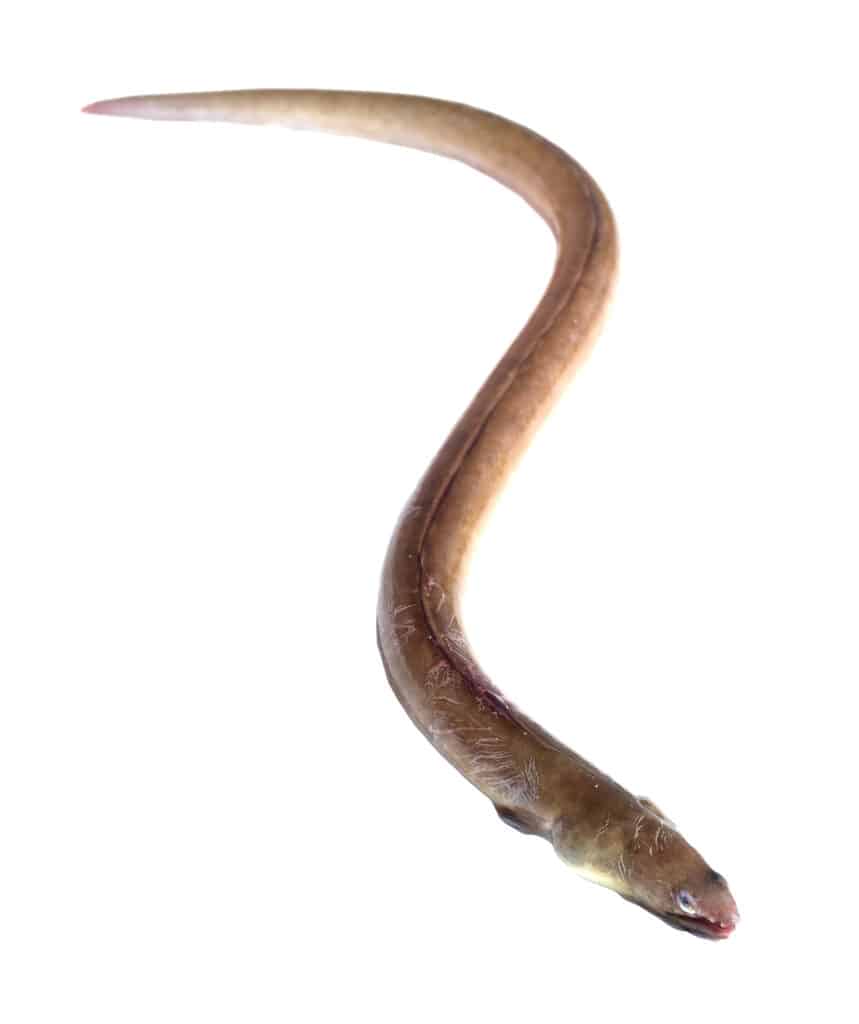Although they might not look like it because of their snake-like appearance, eels are actually fishes. These creatures are ray-finned fish belonging to the order Anguilliformes, consisting of eight suborders, 19 families, 111 genera, and about 800 species. The term “eel” refers to fish such as electric eels, wolf eels, lampreys, and morays along with other true eels.
Regardless of the species in question, eels are very fascinating fish with a lot of unique abilities and features. One of the most striking features of eels is their teeth. If you have always wanted to know more about these fish teeth, this article will help you discover new and exciting facts about their teeth, their appearance, and how they use them.
How To Identify an Eel

The long, sleek body of the American eel can be up to four feet long.
©IrinaK/Shutterstock.com
The body of an eel is elongated, scaleless, and usually laterally compressed, setting it apart from the majority of other fishes. However, because there are around 800 eel species, each one differs from the others in terms of length, color, mouth shape, and fins. Despite this, they still all share some features. All eels have lengthy bodies that resemble snakes or worms with a modified tail fin that really combines the dorsal and anal fins. They also have powerful jaws and tiny, pointed teeth.
Many of these species lack pectoral fins and pelvic fins. Because of their transparency, eel larvae are known as glass eels. They lose their transparency when they become adults.
What Type of Teeth Do Eels Have?

The more teeth an eel has, the better equipped it is for successful underwater hunting.
©Aleksei Alekhin/Shutterstock.com
Like most fish, many eel species have teeth. However, just like how they all have different physical appearances, they also have different dental structures. The more teeth an eel has, the better equipped it is for successful underwater hunting. Although their teeth may appear tiny in comparison to the rest of their bodies, they are strong and capable of causing significant harm. However, most people who have come in close contact with this fish never notice how sharp their teeth are because many of them have two sets of teeth – the first one, which is visible once they open their mouths, and the other in their throats.
Moray Eel
Moray eels are some of the most commonly found eels in the world. In reality, the moray eel belongs to a family of eels that may be identified by their enormous heads, pharyngeal jaws, and stunning colors. The world’s saltwater and freshwater ecosystems are home to more than 200 toothy different species of moray eels. According to experts, moray eels have a set of teeth located within the second set of jaws known as the pharyngeal jaws that aid in capturing their prey.
These apex predators are virtually impossible to escape from because of their large, menacing teeth, which may reach a length of two centimeters (almost an inch). The moray eel uses its pointed front teeth to grasp its meal, which is then quickly grabbed by the pharyngeal teeth and pushed down to the eel’s esophagus. The extra force provided by their pharyngeal jaws helps them in crushing and grinding their food.
European Eel
European eels are predatory fish with one of the most recognizable characteristics of all the fish that inhabit our waters. They have a highly identifiable long, elongated, snake-like body. These eels have tiny scales that are embedded in their skin, despite the fact that their body seems smooth, shiny, and scaleless. These fish also have slime all over them.
European eels have giant mouths that slightly protrude and contain rows of tiny sharp teeth. Unlike moray eels, European eels have just one set of teeth. However, their teeth are equally as sharp because of their dietary choices.
Conger Eel
Conger eels are some of the largest eel species. The conger eel shares many characteristics with other eel species, including a long, slender, snake-like body, a wide, prominent snout, and numerous powerful, sharp teeth that frequently grow in multiple rows. These eels have narrow, closely spaced rows of pointy, triangular teeth. Conger eels hunt for anything that they can catch in their large mouths by swimming close to the ground. These opportunistic predators quickly defeat their victims due to the fact that they have larger teeth in the front and on the roof of their jaws, which aid in the ambush.
Why Do Eels Have So Many Teeth?

Eel teeth are necessary for their survival.
©Rich Carey/Shutterstock.com
The quick and easy explanation for the abundance of eel teeth is that they are necessary for the animals to hunt, feed, and survive. These fish are predominantly predators with carnivorous diets and occasionally cannibalistic behavior. They consume smaller fish as well as crustaceans, insects, shrimp, crabs, and sea urchins. Those in watery settings also eat worms and insect larvae. Along with living prey, freshwater species also consume carrion.
To catch and quickly consume their prey, eels require razor-sharp teeth. Because of their large bodies, they need to eat a lot. These fish also need their many teeth to hunt and feed effectively in order to maintain their position in the food chain and prevent small fish and crustaceans from eluding them.
Do Eels Bite Humans?
Eels are considered some of the most dangerous fishes, but they rarely purposefully attack people unless they are in danger or cornered. Just be aware of them when swimming or fishing, as most eels won’t bite people unless they feel threatened. The likelihood of being bitten by an eel is quite low if you try to stay away from them and show them as much respect as you can.
Eels rarely bite, but if you try to free one that is tangled in a fishing line, they might. On the other hand, most other eel bite incidents in the ocean are frequently thought to be the consequence of mistaken identity, when eels mistake scuba equipment for a small fish.
Up Next:
Moray Eel Teeth: Do Moray Eels Have Double Teeth?
The 10 Largest Eels in the World
The photo featured at the top of this post is © Rich Carey/Shutterstock.com
Sources
- Npr, Available here: https://www.npr.org/2007/09/06/14194579/concealed-weapon-eels-second-set-of-teeth
- Gabe Buckley, Available here: https://biologydictionary.net/moray-eel/
- Justin Shelton, Available here: https://sweetishhill.com/do-freshwater-eels-have-teeth/
Thank you for reading! Have some feedback for us? Contact the AZ Animals editorial team.





